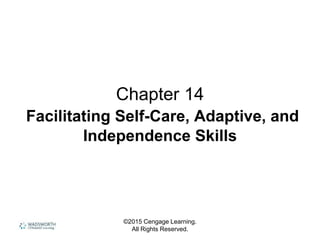More Related Content
Similar to Allen Chapter 14 (20)
Allen Chapter 14
- 2. ©2015 Cengage Learning.
All Rights Reserved.
Definitions
• Functional skills—skills that, if a child
cannot perform, someone does for them.
• Adaptive behaviors are determined by
culture, but include eating, dressing,
toileting.
• Self-determination—people with
disabilities are taking an active role in
making choices about their own life.
- 3. ©2015 Cengage Learning.
All Rights Reserved.
Self-Care Skills and the Curriculum
• Self-care skills are taught so that the
children can be as independent as
possible with or without their disability.
• Culture impacts the age that these skills
are taught.
• They should be taught throughout the day
when they are naturally occurring.
- 4. ©2015 Cengage Learning.
All Rights Reserved.
Self-Care Skills and the Curriculum
(continued)
• Assessment
– What exactly is each child capable of.
– Checklists, developmental profiles, and
professional judgment.
– Child’s typical functioning in familiar
environments.
- 5. ©2015 Cengage Learning.
All Rights Reserved.
Self-Care Skills and the Curriculum
(continued)
• Embedding self-care learning
– Self-care skills should be taught to generalize
skills.
– Self-care skills like eating can combine eating
and pre-academic skills like color words,
vocabulary, and number.
– Communication can take place encouraging a
child to share information during the teaching
of self-care skills.
- 6. ©2015 Cengage Learning.
All Rights Reserved.
Self-Care Skills and the Curriculum
(continued)
• Individualizing self-care programs
– Building independence—allow children to
demonstrate their independence in skills and
practice, practice, practice.
– Building in success—celebrate the success of
doing a skill on their own, rejoice in the
accomplishment.
- 7. ©2015 Cengage Learning.
All Rights Reserved.
When and How to Teach Self-Care Skills
• Let the child do it
– As much as the children are able to do, let
them do.
– Encourage them to try, and reward the
success.
• How much assistance?
– Teachers need to evaluate each child and
learn when to help, how to help, and how
much to help.
- 8. ©2015 Cengage Learning.
All Rights Reserved.
When and How to Teach Self-Care Skills
(continued)
• When to help
– Least intrusive assistance
• Offer help in unnoticeable ways so that the child
feels success.
– Excessive demands for assistance
• Watch for children who are seeking attention by
demanding adult help.
- 9. ©2015 Cengage Learning.
All Rights Reserved.
When and How to Teach Self-Care Skills
(continued)
– Visual cues and supports
• Can increase independence.
– When children can’t
• If a child is having an “off” day, offer support and
encouragement; if needed, a little assistance as
well.
- 10. ©2015 Cengage Learning.
All Rights Reserved.
When and How to Teach Self-Care Skills
(continued)
• Game-like assistance
– Making learning fun is a way to keep a child
involved and interested.
– It is also more fun to play a game than
complete rote practice activities.
- 11. ©2015 Cengage Learning.
All Rights Reserved.
A Systematic Approach to Teaching Self-
Care
• Specify a goal for learning
– Achievable and based on what is
developmentally appropriate.
• Break the skill into small steps
– Task analysis; teach in small steps.
• Using a systematic teaching approach
– Shaping, prompting, fading and cueing
– Forward or backward chaining
- 12. ©2015 Cengage Learning.
All Rights Reserved.
A Systematic Approach to Teaching Self-
Care (continued)
• Using data to evaluate progress
– Monitor behaviors and track effectiveness.
• Modify the teaching as needed
– Review data and examine if teaching
strategies are working.
- 13. ©2015 Cengage Learning.
All Rights Reserved.
Snack Time: An Opportunity to Teach so
Many Skills
• Self-feeding practice.
• Social and communication skills.
• Figure 14.4 for skills and strategies.
- 14. ©2015 Cengage Learning.
All Rights Reserved.
Maturation and Learning: Toilet Training as
an Example
• Can be task analyzed and taught in steps
to children.
• Toilet-training programs
– Commercial programs designed for children
with disabilities.
• Special considerations
– Teach skills from behind child so they do not
have to reverse the behavior.
– Put children in suitable clothing.

